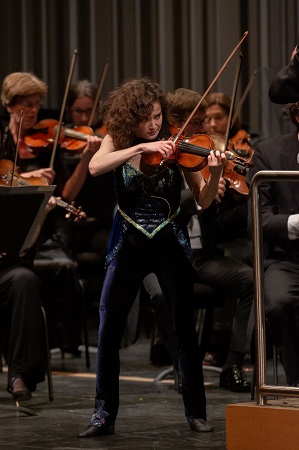 United States Sibelius, Elfman, Prokofiev: Sandy Cameron (violin), Royal Scottish National Orchestra/Thomas Sønderård (conductor), The Soraya, CSUN, Northridge, 4.4.2019. (DD)
United States Sibelius, Elfman, Prokofiev: Sandy Cameron (violin), Royal Scottish National Orchestra/Thomas Sønderård (conductor), The Soraya, CSUN, Northridge, 4.4.2019. (DD)

Sibelius – Symphony No.7 in C major Op.105
Elfman – Concerto for Violin and Orchestra, ‘Eleven Eleven’
Prokofiev – Symphony No.5 in B flat major Op.100
The major works by Sibelius and Prokofiev that book-ended this program were reason enough to draw the attention of music lovers. Sibelius’s final and rarely performed single-movement symphony is one of the great musical summations; although he would live several decades longer, No.7 and the symphonic poem Tapiola stand as his last important works. Prokofiev’s Symphony No.5 is easily among the handful of symphonic masterpieces of the past century.
But the central work on the program was the Concerto for Violin and Orchestra, ‘Eleven Eleven’ by Danny Elfman, a composer best known for his work with Oingo Boingo (of which Elfman was a co-founder) and his ingeniously original television and film scores, including those for The Simpsons, Desperate Housewives and Tim Burton collaborations such as Pee-wee’s Big Adventure.
‘Eleven Eleven’ was first performed in 2017 by the Czech National Symphony Orchestra with violinist Sandy Cameron of Cirque du Soleil fame. Talk about Big Adventures! From all that I’ve been able to glean, the work was the product of Elfman’s close and obsessive study of classical violin concertos and related works. Having now heard it, I think it impossible that Elfman wouldn’t have spent a considerable time with Paganini’s 24 Caprices, along with the sonatas and concertos.
In Elfman’s brief but detailed essay about the work, he writes about wanting to compose music that might prove challenging to the ear of a cinephile while satisfying the classical music lover’s need for complexity and variety. To my ear, he succeeds in every way. The almost pastoral fullness that opens the concerto, the continual virtuosic displays and the detailed intricacy in orchestration were only some of the hallmarks. The third movement of the concerto, in a steady triple meter, seemed at times to be a kind of frozen music where deathly marches melt into lush, dream-like passages. The last movement enters with a brief and ingenious recapitulation of what had passed earlier in the concerto. It’s a beautifully balanced composition, continuously inventive while tethered to a significant structure.
And how funny so much of this music is! The rhythms that bounce along, crescendos that crest like ocean waves in volume and density only to disappear into droplets, machine-like moments of forward motion offset by aural pratfalls – yes, you can have ‘aural pratfalls’ – only to morph into heartbreaking sorrow.
Of course, much of the score is not comedic. I was reminded of a lecture I heard decades ago by a renowned classics professor who spoke at length on the loss of Aristotle’s treatise on comedy (we are in possession of his work on tragedy), but Elfman seemed able to express the whole of Aristotle’s Poetics (including that lost portion) in his wondrous musical creation. Such playful, humorous music; such doleful, tragic music.
Violinist Sandy Cameron really deserves an essay in her own right. She dances literally and sonically while she plays, expressing pulse and movement with ease, grace and muscularity. Her visual performance is not an exaggerated version of the movements we find with many performers but rather an integral part of this musical composition. Cameron is a dance/movement artist-cum-virtuoso violinist, and her onstage presence begs the question of the relative importance of ‘seen’ versus ‘heard’.
Elfman writes of Ms. Cameron: ‘I knew I had encountered a rare and very odd creature: a concert violinist who had literally run away with the circus . . . I recognized right away that her abilities far exceeded the music I had written for her’. He also graciously acknowledged that she was part of a collaboration that resulted in this concerto: a composition like no other, performed by a soloist like no other.
The two symphonies on the program were intelligently chosen and superbly executed. The Sibelius No.7, a single-movement work of clearly delineated sections, alternates between passages of grandeur and intimacy, and Conductor Sønderård seized upon this characteristic structure. Much has been made of the conjuring of natural phenomena here – rivers, storms, winds and more – but the human element, especially the ‘better angels of our nature’, seemed to be the prevalent theme.
Prokofiev’s Symphony No.5 is a work often described as the pinnacle of his symphonic output, and it’s difficult to argue with that: each of the four movements is a stand-alone masterpiece. In both individual and ensemble roles, the Royal Scottish National Orchestra handled this beautiful monster with dexterous ease. Detailing the finer points of the performance would be a fool’s errand: the orchestra is at the top of its form and, were I to cite all of the excellent individuals, I would exceed my word limit. Nevertheless, clarinetist Matt Glendening, oboist Adrian Wilson, flutist Katherine Bryan and principal horn Christopher Gough (and the entire horn section) all deserve mention. The percussion section looked like they were having a ball, and I was too.
Douglas Dutton